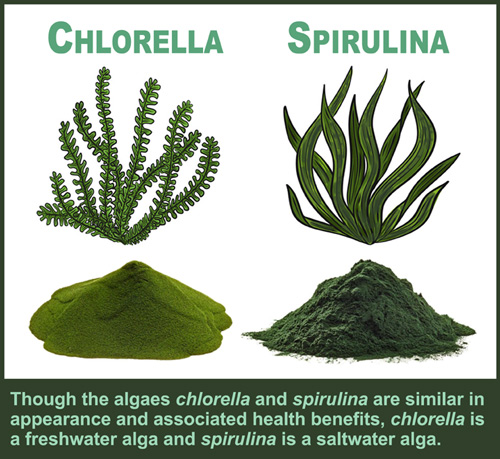If you feel tired, regularly suffer brain fog, or suddenly struggle with several seemingly-unrelated health issues at once, a build-up of toxins in the body may be to blame.
Everyone suffers from some degree of toxic build-up—it’s impossible to avoid it in a modern society—and the body is designed to detoxify automatically. However, millions of people today suffer symptoms caused by a constant onslaught of heavy metals, plastics and pesticides that surpass the body’s normal capacity to cleanse itself.
This toxic overload is not surprising considering studies show more than 80,000 chemicals have been released on the planet since World War II. Moreover, most people consume unhealthy foods that further diminishes the body’s capacity to detoxify.
Fortunately, there are powerful nutrients that can help—and one of the most potent is algae. Algae provides such potent detoxification benefits that it was used to help survivors of the atomic bombings of Japan in the 20th century and victims of nuclear power plant accidents in the 21st century.
Algae basics
Algae are a large and diverse group of photosynthetic, plant-like organisms that use chlorophyll in capturing light energy, but lack characteristic plant structures such as leaves, roots, flowers and seeds. Algae can grow in freshwater, saltwater, or a combination of both.
Algae range from single-celled organisms to multi-cellular organisms with fairly complex differentiated forms. The large multi-cell forms in the oceans of the world are called “seaweed.” In short algae can range in size from microscopic to over 100 feet long.
In addition to acting as a binding agent to draw toxins out of the body, algae is extremely nutrient dense. Algae contains high concentrations of proteins, minerals, antioxidants and essential fatty acids. It even contains unique chemicals that have been shown to repair DNA. No wonder it’s referred to as a superfood.
The two algae strains that are best known in the sphere of nutritional supplementing are spirulina and chlorella. Spirulina is a blue-green algae that grows in saltwater conditions, while chlorella is solely green and grows in freshwater environments. Unlike seaweed, these two strains of algae do not contain iodine.
Spirulina
Spirulina is known for boosting energy, improving mental clarity, and reducing hunger. It contains a unique, water-based, antioxidant pigment called phycocyanin. This pigment has powerful neuroprotective and anti-inflammatory properties.
Spirulina also is rich in DHA (Docosahexaenoic acid) and GLA (gamma-Linolenic acid) essential fatty acids. GLA is an omega-6 fatty acid, but its metabolism in the body similar to that of Omega-3s—meaning it provides anti-inflammation, hormone-balancing and brain protection properties.
Spirulina was part of a regimen used to treat victims of the catastrophic nuclear accident at the Chernobyl Nuclear Power Plant in the former Soviet Union in 1986.
In fact, later, in the mid-1990’s, a Russian patent was granted for the use of spirulina as a specific immune enhancer in the treatment of children affected by the Chernobyl disaster.
Some of the research that led to granting the patent included testing done in 1990 in Belarus. This study concluded that spirulina consumption “promotes the evacuation of radioactive nucleotides from the body.”
Studies also showed that the consumption of spirulina reduced the radiation load of strontium and cesium that was ingested in contaminated foods.
The other alga
Going large
Kelp is another type of algae that is used for food and supplements. Kelp is a large brown seaweed—and seaweed itself is a type of algae. Most algaes are are small, even microscopic, but kelp can be dozens of feet long.
While kelp shares a similar nutritional profile to chlorella and spirulina, a major difference is that kelp is rich in iodine. Kelp is also well-known as a food source in many countries of the world—especially in East Asia—while chlorella and spirulina are primarily cultivated to make nutritional supplements.
Learn more about kelp in our previous post here.
Another comparative study found patients diagnosed with radiation sickness experienced “long- lasting remission” from radiation damage as well as “reconditioning of cellular functions” when treated with spirulina.
A similar 1993 study, conducted at the Research Institute of Radiation Medicine in the Czech Republic, found that five grams of spirulina daily reduced radioactivity levels by 50% in 20 days in children suffering radiation sickness.
Chlorella
Chlorella has similar attributes when it comes to protecting the body from radiation. Like spirulina it also promotes healing after damage has occurred.
With twice the amount of chlorophyll as spirulina, chlorella was used to help Hiroshima survivors detoxify from radiation after the atomic bomb was dropped on the Japanese city in 1945. Decades later, chlorella was again used in Japan following the Fukushima nuclear powerplant accident.
In the decades following Hiroshima scientific studies coroborated the protective benefit. A 1993 study, conducted at Jawaharlal Nehru University in India, observed that chlorella produced “a significant radio-protective effect against both acute and chronic radiation damage.”
Research shows the reason chlorella is able to remove toxins so efficiently is due to its hard cellular wall. The hard wall attaches to toxins and draws them out of the body’s organs and blood and carries them safely out of the body.
Understanding “toxic” algae blooms
Unfortunately the media frequently gives the impression that algae is, itself, toxic and dangerous. A “toxic overgrowth of algae” is often blamed for shutting down beaches and killing wildlife; however, it’s not the algae that’s causing the problem—it’s the toxins in the water that attracted the algae.
In short, the algae build-up is just the end result of the toxin build-up; it is not the cause of the build-up. In fact, this is what algae is supposed to do, and it proves algae’s effectiveness in attracting toxins.
With this in mind, the way to fix algae overgrowth is not to villify algae, but to reduce the toxicity level where overgrowth occurs.
While media outlets often run the words “algae” and “toxicity” together in the same sentence, studies have shown that less than 1% of algae produce enough toxins to kill sea life and birds, or cause illness in humans.
It is also important to understand algae is never toxic when it is grown as an agricultural crop in controlled environments. These crops are grown specifically to be a nutrient-dense food source and nutritional supplement.
If you want to benefit from the toxin-protecting benefit of chlorella and spirulina, check out the following Optimal Health Systems products:
• Exposure Protection Pak.
• Pre-Conditioning Pak
• Opti-Adrenal
• Natural Z Pak
– – –
Sources: •”How to Help Support the Body’s Healing After Intense Radioactive or Radiation Exposure” by Bill Bodri, 2004 •PubMed.gov (2000 Ukrainian study) •Annals of the New York Academy of Sciences (PubMed 2008).


